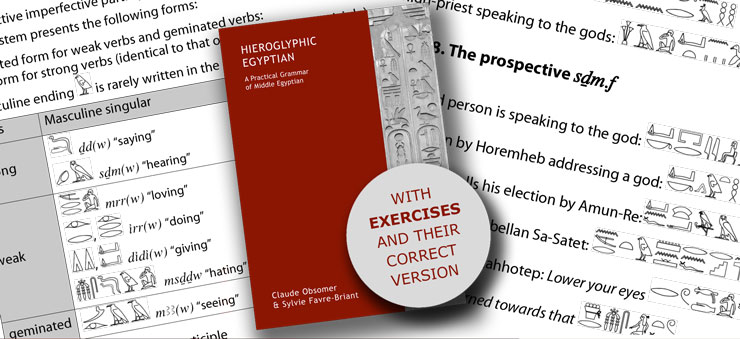2016. Available
A Practical Grammar of Middle Egyptian
The authors | Target audience | Contents | View a few pages in PDF || En français
This manual presents a pedagogical approach to the grammar of Middle Egyptian, the classical language of pharaonic Egypt. It is the English version of the second edition of the Grammaire pratique du Moyen Egyptien, published in the same Series.
The first part of this grammar book is dedicated to hieroglyphs. It provides an explanation of this writing system, presenting a selection of the 200 most important signs to memorise, as well as a basic vocabulary list that is easy to learn. Another page of this webpage includes an animation showing how to draw all these signs (  See).
See).
The grammatical commentary begins with an overview of the main types of clauses attested. It goes on with a systematic study of nouns and associated elements (adjectives, determiners, genitive constructions, prepositions, pronouns), the examination of non-verbal clauses, for which a verb “to be” will be introduced in the English translation, and the description of suffix and non-suffix verbal forms (morphology and syntax). It closes with a summary of the uses of auxiliaries and particles.
In addition to the grammatical explanations, the work presents a series of common phrases and expressions: names of kings and individuals, a selection of anthroponyms and titles, and expressions used in traditional funerary inscriptions.
The work continues with a list of more than 800 signs, a vocabulary list of more than 2,300 words, the references to the examples quoted, and a chronological table.
The third part concludes with a series of exercises and their correct version.
View a few pages in PDF
The authors
Claude OBSOMER, Professor of Egyptology (University of Louvain-la-Neuve, Belgium)
Sylvie FAVRE-BRIANT, Academic Degree in English (Sorbonne, France) and in Ancient Languages - Classical Egyptian (University of Strasbourg, France), Member of the Académie Belge pour l'Étude des Langues Anciennes et Orientales (Belgium)
Target audience
This manual, intended for university teachers and students, will also appeal to amateurs who would like to learn, on their own or with a group, the Egyptian writing and language in order to read ancient texts.

Contents
Introduction
A. Language and writing
B. Deciphering hieroglyphs
C. Selected bibliography
Chapter One — Egyptian hieroglyphic writing
General remarks
A. A short introduction to hieroglyphs
B. The three main functions of signs
C. Phonetic signs or phonograms
D. Determinatives
E. Ideograms
F. Comments on spelling
G. Characteristics of the writing system
Chapter Two — From words to clauses
Introduction
A. Examples of non-verbal clauses
B. Examples of verbal clauses
C. A comment on the suffix pronoun
D. Royal cartouches
Chapter Three — Nouns and nominal groups
A. Nouns
B. Adjectives
C. Elements of nominal syntax
D. Prepositions and conjunctions
E. Numbers and dates
F. Personal pronouns
G. Demonstratives and possessives
Chapter Four — Non-verbal clauses
A theoretical approach
A. Non-verbal clauses with nominal predicates
B. Non-verbal clauses with adjectival predicates
C. Non-verbal clauses with adverbial predicates
D. Negation of non-verbal clauses
E. Non-verbal clauses expressing existence
F. Non-verbal clauses expressing possession | | Chapter Five — Verbs (non-suffix and relative forms)
A. The classification of verbs (verbal roots)
B. The infinitive
C. The imperative
D. The participle
E. The “relative form”
F. Summary of “relative clauses”
G. The “negative verbal complement”
Chapter Six — Verbs (suffix forms and verbal clauses)
A theoretical approach
A. Regular forms of the perfect
B. The imperfect
C. The prospective
D. Rare forms of the suffix conjugation
E. Passive suffix forms
F. Negative verbal clauses
G. A practical approach to the sdm.f and sdm.n.f forms
H. The pseudo-participle (or old perfective)
Chapter Seven — Particles, auxiliaries, interrogative words
A. Proclitic particles and auxiliaries
B. Enclitic particles and adverbs
C. Interrogative words
Chapter Eight — Specific expressions
A. Names of kings
B. Names of individuals
C. Expressing filiation
D. Funerary formulas
Chapter Nine — Resources
A. List of hieroglyphic signs
B. Egyptian-English vocabulary
C. Reference list of examples cited
D. Chronological table
Exercises
A. Hieroglyphic writing and vocabulary (ex. 1 to 23)
B. Nouns, pronouns and nominal groups (ex. 24 to 35)
C. Non-verbal clauses (ex. 36 to 41)
D. Verbs and verbal clauses (ex. 42 to 64) |